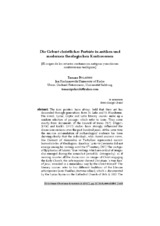Die Geburt christlicher Porträts in antiken und modernen theologischen Kontroversen
El origen de los retratos cristianos en antiguas y modernas controversias teológicas
Autor
Polánski, Tomasz
Editor
Universidad de Córdoba, UCOPressFecha
2017Materia
Early Christian and Byzantine artIcons
Theological controversies
Edessa/Urfa
Council of Nicaea (787)
Cristianismo primitivo y arte bizantino
Iconos
Controversias teológicas
Edesa/Urfa
Concilio de Nicea (787)
METS:
Mostrar el registro METSPREMIS:
Mostrar el registro PREMISMetadatos
Mostrar el registro completo del ítemResumen
The icon painters have always held that their art has descended through generations from St. Luke and St. Nicodemus. The Greek, Syriac, Coptic and Latin literary sources make up a random selection of passages which refer to icons. They come mostly from documents of the Council of Nicea (787). Elliger’s (1930) and Koch’s (1917) studies have strongly influenced the discussions on icons over the past hundred years. At the same time the massive accumulation of archaeological evidence has been showing clearly that the individuals, who shared aniconic views, like Clement of Alexandria or Tertullian represented narrow learned circles of theologians. Eusebius’ Letter to Constantia did not emerge among his writings until the 8th century (787). The vestiges of Epiphanius of Salamis’ four writings which are critical of images also emerged during the iconoclast period (G. Ostrogorsky). As if running counter all the discussions on images of Christ engaging the Early Church, the acheiropoietoi showed Christians ‘a true face’ of Jesus, revealed in a miraculous way by the Christ Himself. The literary sources refer to two different traditions of the Edessan acheiropoietos (Acta Thaddaei, Doctrina Addaei), which is documented by the Syriac hymn on the Cathedral Church of Urfa (c.550). The popularity of images in the 4th – 7th century would have been unthinkable without a long, earlier history. Los pintores iconoclastas siempre han mantenido que su arte desciende a través de generaciones de Lucas y San Nicodemo. Las fuentes literarias griegas, siriacas, coptas y latinas ofrecen una selección de pasajes que hacen referencia a los iconos. Provienen principalmente del Concilio de Nicea (787). Los estudios de Elliger (1930) y Koch (1917) han marcado la discusión sobre los iconos a lo largo de los últimos cien años. Al mismo tiempo, la gran acumulación de restos arqueológicos ha ido mostrando que aquellos individuos con una visión anicónica, como Clemente de Alejandría o Tertuliano, representaban un círculo reducido de teólogos. La Carta a Constancia de Eusebio no surgió entre sus escritos hasta el s. VIII (787). Las huellas de los cuatro escritos de Epifanio de Salamina que son críticos con las imágenes también surgieron durante el periodo iconoclasta (G. Ostrogorsky). Y como si fuera contrario a todas las discusiones sobre imágenes de Cristo relacionadas con el cristianismo primitivo, el acheiropoietoi mostró a los cristianos el “verdadero rostro” de Jesús, revelado de manera milagrosa por el propio Cristo. Las fuentes literarias hacen referencia a dos tradiciones diferente sobre el acheiropoietos de Edesa (Acta Thaddaei, Doctrina Addaei), que ha sido documentado con el himno siriaco de la iglesia catedral de Urfa (c.550). La popularidad de las imágenes en los siglos IV-VII no podría pensarse sin una larga y previa trayectoria histórica.

